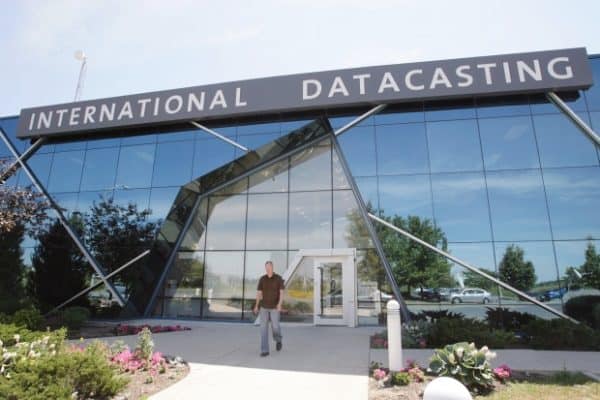
International Datacasting board member Adam Adamou says his strategy has been wrongly characterized as based solely on acquisitions. If you haven’t been watching, the International Datacasting (TSX:IDC) proxy battle has been heating up ahead of its AGM July 31st.
First, IDC Director and former Executive Chairman Adam Adamou filed a dissident proxy circular urging shareholders to vote for director nominees he said would stand for “for positive change” for the struggling Ottawa satellite player.
Then, last week, the company fired back in a press release, correcting “the misinformation” in Adamou’s circular. That release said Adamou’s business acquisition strategy was wrongheaded, wasteful and, ultimately unsuccessful.
Adamou responded to that release the next day with a press release of his own, saying that “This kind of approach by the IDC board is simply an attempt to distract shareholders from focusing on the real issues of strategy, revenues, growth and the future. We don’t think it will work. Shareholders are telling us that they are embarrassed by these negative releases and that they see them as an inappropriate use of corporate funds by an embedded board using company resources to maintain control at all costs.”
Today, another release, this one penned by IDC CEO Fred Godard who said Adamou’s strategy was “high risk” and that he would not accept the invitation to serve on the board slate proposed by Mr. Adamou.
Cantech Letter caught up with Adam Adamou to get his reaction to the most recent developments.
Adam, there’s been a lot of mud slinging lately, is this getting too personal for you?
No. The decision by IDC to go negative is a tactical one on their part, I don’t take it personally. It speaks to their approach to shareholders and to the process in general. Shareholders that care enough about IDC to vote will choose ideas over mud anytime. They’re tired of these tactics. It won’t succeed, shareholders won’t let it.
IDC is claiming that your business acquisitions strategy is expensive, has failed and that it should be killed. What do you say to those statements?
The strategy was unanimously approved by the board and by the shareholders. It was deemphasised because of the agendas of various personalities on the board – not because it wasn’t successful. Fred’s statements about the strategy are surprising considering that he was negotiating to join our slate just last week…
Fred actually negotiated to join your Blue slate?
Yes, just over a week ago. He entered into a discussion with me over the phone and forwarded to me via email a proposal that would add a former member of the board of his prior company to our slate. We considered his offer and rejected it as not being consistent with the kind of corporate governance practices that we are going to build at IDC. The fact that he entered into active negotiations to join our slate show’s that he’s not as opposed to our strategy as his public statements would indicate. Notwithstanding his comments, I don’t actually think that Fred will resign from the board when we’re elected. We’ll see what happens, but I doubt that he will.
Does that mean that Fred is no longer going to remain on your slate?
Fred is on our slate, we’re not going to be changing things around just weeks before our annual meeting. Should Fred decide to resign once he is elected, we will accept his resignation as a director and ask him to focus on his management role of driving business operations without any board level distractions. That should be good for him and good for the shareholders. We will then take our time to find an excellent alternative rather than rushing in the next few days to add a name to replace him.
_____________________________________
This story is brought to you by Zecotek Photonics (TSXV:ZMS). As of November 16, 2011, Zecotek owned title to or controlled more than 55 patents and applications. Click here to learn more.
______________________________________
IDC announced that they were paying $165,000 to a proxy solicitation firm, this is getting pretty expensive isn’t it?
Yeah, plus $8 per phone call for two weeks of work. The cost will likely be in the $250,000 range based on similar agreements. They will one the one hand look to secure votes for their side, and on the other hand they will go through the Blue proxies with a fine tooth comb to identify reasons to deny our shareholders their vote. To the extent that they have a vision, this is it.
Not an insignificant amount of money..
That’s a lot of money and it belongs to our shareholders and not to the board. There’s so much that we can do with this money if we were to invest it productively rather than just to protect our vested interests. We could invest in our core technologies, provide incentives for staff to meet development deadlines, put it into marketing, or sales or purchase more of our shares under our issuer bid. We’ve been reducing expenses, announcing layoffs and talking about cost cuts… and in the face of this, they decide to spend this kind of money on soliciting shareholders or by using tactics to eliminate their votes. It makes me sad more than angry.
In IDC’s statements it sounds like your strategy is solely an acquisitions based strategy. This doesn’t seem to be what you are saying in your material ( The Circular for Positive Change )…
No it isn’t. We believe that IDC is on solid ground with some good products and good people. We make more of an emphasis in our Circular for Positive Change on the fact that the markets that we sell in to are not growing and that we need to grow in order to generate shareholder value. Our product revenues are now lower than they were when Fred came on as CEO because our markets are shrinking and our margins are under pressure. We make more of an emphasis on the fact that the markets that we sell into need to be growing.
And how would you do that?
We plan to make the best of our technology today and to continue to expand it to deliver operational excellence while also paying attention to where our industry is headed – namely content to any device from any pipe. This is clearly what is happening in the industry and we can be a part of it from a position of strength.
What about the new initiatives that the company has announced? Laser and Tattoo?
Those initiatives were approved under the business acquisitions strategy and are consistent with our plan. We support well thought out business plans that come with milestones and that offer strong risk adjusted rates of return. They are certainly very risky though – you don’t just enter into a $400 million market as a small company and expect to take it over. It’s hard work that will require a lot of effort with a pilot, followed by an initial order as a proof of concept, followed by execution on the order and so forth. You also have a tremendous amount of competitive pressure from other firms. The success of these products has no impact on the rest of our strategy and of course we’re cheering for them to succeed. Our job is to monitor the progress of these projects against their business plans and to make decisions accordingly. They’re completely complimentary and they were approved under the current business acquisitions strategy.
Beyond these organic initiatives, what kind of third party acquisitions have you looked at – can you give us some details?
Without getting into specific names, we went into the due diligence stage with two companies over the last twelve months. One was a company in the ancillary data and interactive television space. They have about $6 million in revenue with operations in the UK and in the US. Their largest customer is also one of our largest customers. We were to pay $1.5 million on closing, and an additional $1.125 million would be paid out of the acquired company’s operating cash flow payable against minimum profitability targets. We would also issue 2.3 million IDC shares to the employees of the acquired company. It worked out to less than 3X operating cash flow for the entire company – and less if they met their profitability goals.
It was profitable?
The company realized adjusted EBITDA of $750,000 and had $1.8 million dollars on the balance sheet. Even with the $1.5 million payable on closing, we would have ended up with with more cash on the balance sheet than before the acquisition. The balance owing would only be paid if the company generated at least $2.25 million in cash flow over the next few years. We would keep the company as a separate subsidiary to protect IDC’s assets from any liabilities in the acquired company. It is a fantastic asset at a great price. It was really painful to let it go.
Why did the board reject it?
The Investment Committee approved the Letter of Intent but the board did not see the final document. I was working on the due diligence in the UK – we have a very extensive process, and I received an email telling me that the Investment Committee had decided to pass on the transaction before they even had a chance to look at the final details of the business. This was in August, 2011 less than thirty days after our annual meeting. We were planning on closing the transaction in September and announcing it at the IBC show.
What was the explanation for rejecting it?
Jim Hall was in favour of having me finalize the due diligence and to have the recommendation properly reviewed by the Board. The other members of the Investment Committee mentioned something about working on bigger transactions or that the UK was too far away. I thought that focusing on larger transactions, say in the $20 million to $30 million dollar range, were too risky and inconsistent with our strategy and that the UK would make a great lower cost adjunct to our operations in the Netherlands. The US operations would also provide a northeastern beachfront for the company. I wanted to focus our first few acquisitions on companies that could stand alone and that required minimal supervision from the IDC side. This company had an excellent CEO in his late thirties and I could see him rising up the ranks to potentially lead our combined business over the next five to ten years. Beyond the assets and revenues, this is what you’re really buying in an acquisition, a solid management team that can provide breadth across the company.
What else were you working on?
There was one other one, a public company and I’ll keep it vague to protect them. It is a North American company in the mobile space with over $10 million in cash on the balance sheet and between $9 million to $11 million in trailing revenues. It’s been profitable over the last five or six quarters, but marginally so. Upon consolidation the combined company would have had almost $20MM in cash, revenues in the mid $40 million range and strengths in both satellite and mobile to fill two of our pipes. We were planning on changing the parent company name and the ticker symbol and relaunching both companies. Because both companies are listed on senior exchanges, savings on listing, filing, accounting and legal expenses alone were in the $1 million range and these savings would be immediately realized with really no risk because you only need one audit, one listing, one legal firm and one set of public company expenses.Each company was to be a separate subsidiary to protect the assets of one business from the liabilities of the other. The transaction ultimately died due in large part to infighting among certain members of our board that were completely unrelated to the quality of the transaction.
How much were you going to pay for them?
Again, keeping things broad for the purposes of confidentiality, at our current share price the purchase price would have been $10.5 million to $11.5 million in IDC shares or, net of cash on their balance sheet between $500,000 to $1,000,000 for 100% of the company. On a trailing basis, about 1X operating cash flow.
How did you negotiate that kind of a deal?
We sold a vision. Both of our companies are struggling in niches, share volumes are low, and our shareholders are restless for change. We both agreed that the best way to move forward was to embrace our business acquisitions strategy. We sold them on the strategy, and they accepted the vision and were excited by it.
Is there any chance of going back to them?
Never say never. My objective would have been to complete both of these transactions. Coming into this July AGM – we would be showing revenues of about $50 to $55 million and more than $20 million in cash on the balance sheet, and a positive bottom line. With about 80,000,000 shares outstanding assuming that both transactions closed as they were structured – how much would that company be worth? Would you rather be an investor in that company or this one? With operations in ancillary data, interactive television, digital content, mobile devices and satellite. Which one is riskier? There’s a lot of opportunity out there for savvy buyers. In the cases above – investing in tried and true technologies, with real customers, real revenues and real products makes a lot of sense at the prices that we were able to negotiate. Not moving forward with these transactions has increased the operating risk of our single niche. This is a great time to be a buyer and a horrible time to be a seller.
Is that the biggest difference between you and the other side – buy vs. sell?
That’s one difference… a big difference. Our slate believes in our core products but believes that expansion is possible through the kind of transactions that we’ve described above. That’s what you do if you want to grow the company. If, on the other hand your objective is to sell IDC – then you want to keep it pure and tight to keep the story simple for prospective buyers. The prices that we will realize on a sale – given the relative valuations – will not be favorable to our shareholders. To realize this kind of valuation after 27 years in business, it really would be a tremendous disappointment to our shareholders. That’s why they are rejecting the IDC model and supporting our Blue Proxy.
_________________________________
________________________________
Leave a Reply
You must be logged in to post a comment.






 Share
Share Tweet
Tweet Share
Share




Comment